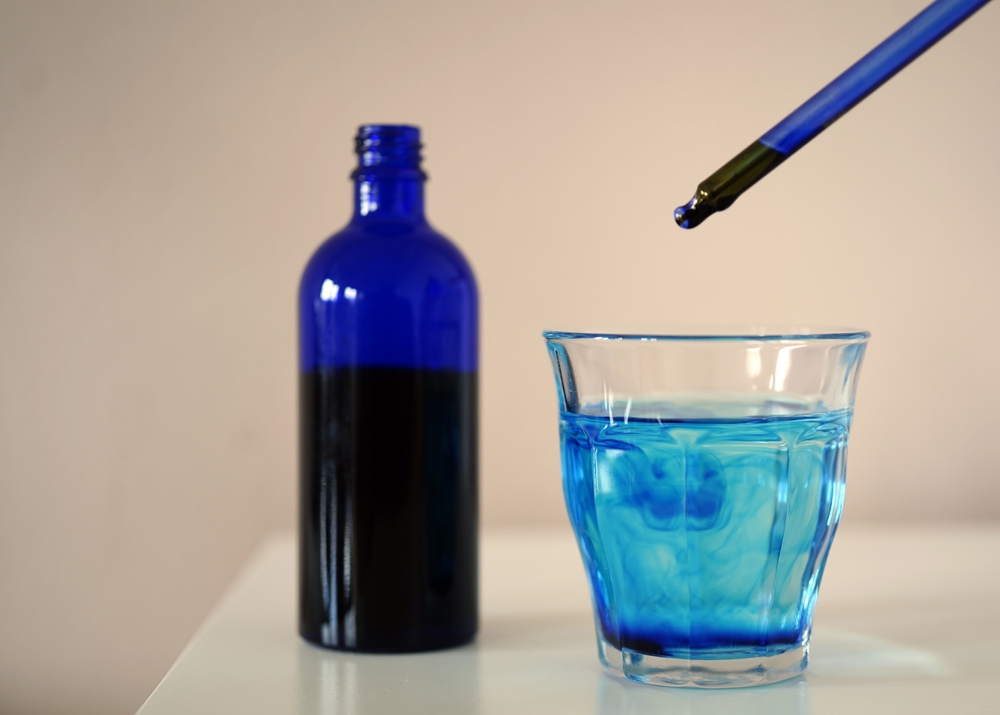Every day, it seems like there is a new injection, pill, powder, or peptide that claims to be the next big thing in health and wellness. The latest to gain popularity and even inspire a best-selling book that people in the biohacking and functional medicine space can’t stop talking about is methylene blue.
While a quick search may first highlight its history as a dye or its role in treating a rare blood condition, methylene blue is finding its way into many health applications and even being called a “miracle” molecule by many in the biohacking community.
Methylene blue is certainly sparking interest because of its wide range of therapeutic benefits. However, like any emerging health trend, it’s important to sift through the hype and focus on the facts.
In this post, we’ll explore what methylene blue is, how it’s being used in the medical field, and its many uses, particularly its energy-boosting benefits.
What is Methylene Blue?
If you google “what is methylene blue” you will see a lot of different descriptions. It might be described as a dye, chemical compound, molecule, or medicine. All of those descriptions are actually correct. Which makes it even more confusing, huh?
And we know what you might be thinking. How could something used as a dye also be good for you?! It’s all about context. Yes, methylene blue started as a dye, but it evolved into a therapeutic molecule with a lot of potential medicinal uses.
The history of methylene blue spans all the way back to the mid-1800s. It was first developed as a dye and primarily used in the textile industry to color fabrics. Not long after, it became a staining agent in microbiology to identify bacteria and parasites under a microscope.
Its unique chemical properties got researchers thinking—if the dye highlighted bacteria and parasites, could it possibly be used to destroy them? Sure enough, it did!!
Methylene blue earned its claim to fame as the first synthetic drug successfully used to treat malaria. This made it one of the very first laboratory-made drugs used for medical purposes.
A few years later, methylene blue became the standard treatment for methemoglobinemia, a condition where the blood loses its ability to carry oxygen effectively.
Fast forward to the mid-20th century and into the 21st century, and things get even more fascinating. Scientists began to uncover a much broader potential for methylene blue.
Researchers discovered it had applications in areas like:
- Combating oxidative stress that is often seen in conditions like chronic fatigue.
- Neurodegenerative diseases, such as Alzheimer’s.
- Psychiatric treatments, particularly for mood disorders.
- Urinary tract infection treatments.
- Cancer therapies targeting specific cellular functions.
- +++ more
This list of the potential therapeutic uses for methylene blue has grown substantially over the years. We’ll go over all of them and who could benefit most from methylene blue next.
But first, let’s answer another pressing question people have… how does methylene blue work to help treat so many different conditions?
How Does Methylene Blue Work?
Methylene blue is unique in that it works through multiple mechanisms, which is why it’s being explored for such a wide variety of health benefits.
At its core, it helps cells function better, especially when they’re under stress or struggling due to illness or aging. But that’s just the beginning.
Here are several ways methylene blue works in the body to improve health and treat various conditions:
Enhances Cellular Energy Production
One of methylene blue’s most powerful benefits is its ability to improve the efficiency of energy production in your cells. Inside every cell are tiny structures called mitochondria that generate ATP. This is the molecule your body uses as its primary energy source.
As we age or when the body experiences stress or disease, these mitochondria can become less efficient, leading to lower energy levels and fatigue. Methylene blue is believed to help optimize mitochondrial function, enabling cells to produce energy more efficiently.
Neutralizes Oxidative Stress
Oxidative stress occurs when the body produces more free radicals (unstable molecules) than it can manage. Free radicals are a natural part of life. But factors such as aging, pollution, smoking, poor diet, and chronic stress can lead to an overload of them or a shortage of antioxidants to counteract them.
When this imbalance occurs, free radicals can damage healthy cells by attacking their membranes, proteins, and DNA. This damage disrupts normal cellular functions, promotes inflammation, and increases the risk of chronic diseases like heart disease, diabetes, and neurodegenerative disorders.
Methylene blue is believed to act as an antioxidant, helping to neutralize harmful free radicals and reduce oxidative stress.
Improves Blood Flow and Oxygen Delivery
Methylene blue is thought to improve red blood cells’ ability to carry and release oxygen. This support may help reduce strain on the cardiovascular system, boosting overall health and cardiovascular function.
Antimicrobial Effects
Methylene blue’s ability to act as an effective antimicrobial agent was first discovered after successfully treating malaria. Since then, researchers have found that it shows promise in combating various infections by disrupting the metabolism of pathogens like bacteria, fungi, and viruses, making it harder for them to grow and reproduce.
This antimicrobial action, along with its ability to support the immune system, makes methylene blue helpful in fighting infections, including those caused by antibiotic-resistant bacteria.
Can Cross the Blood-Brain Barrier
One of methylene blue’s unique abilities is its capacity to cross the blood-brain barrier—a protective layer that restricts substances from entering the brain. Once it reaches the brain, methylene blue has been shown to support healthy brain activity by enhancing mitochondrial function in brain cells.
Mitochondria in the brain help produce ATP, the energy source needed for proper brain function. By improving mitochondrial efficiency, methylene blue helps the brain cells produce more energy, which can improve cognitive function, memory, and mood.
Who Might Benefit Most from Methylene Blue?
What was once thought to be just a coloring agent or a treatment for a small number of conditions is now being hailed as a “miracle” molecule, offering possibilities far beyond its original uses.
Here are a few scenarios where it may be especially beneficial:
Anyone Who Needs an Energy Boost
Methylene blue has been shown to increase energy levels, boost endurance, and improve focus, making it an option for anyone who could use a natural energy boost. It is believed to be able to do this due to its ability to enhance cellular energy production by supporting mitochondrial function.
Chronic Fatigue
Methylene blue may help combat fatigue by enhancing the mitochondria’s ability to produce ATP. This boost in cellular energy production can improve stamina and resilience.
Age-Related Energy Decline
As we age, mitochondrial function naturally declines, leading to lower ATP production and reduced energy levels. Methylene blue may help to restore mitochondrial efficiency, supporting energy production and combating the fatigue that often accompanies aging.
Skin Concerns (Anti-Aging)
The aging process can lead to oxidative stress, which damages skin cells and accelerates aging signs like wrinkles and sagging. Methylene blue boosts energy production at a cellular level, which can potentially improve skin vitality.
Additionally, its antioxidant properties may protect skin cells from oxidative damage, helping slow down the signs of aging and supporting healthier skin.
Anyone Concerned with Cognitive Decline
Methylene blue is believed to improve mitochondrial function in brain cells, which can improve brain health and cognitive performance. Studies have shown promise in supporting cognitive function that may help protect the brain from age-related cognitive decline, including conditions like Alzheimer’s disease.
To Enhance Mood
Methylene blue’s ability to enhance mitochondrial function and boost energy levels may also help alleviate the fatigue and low energy often associated with mental health conditions. For these reasons, it’s being studied in many psychiatric applications as an adjunct treatment for mood disorders like depression and anxiety.
What Conditions Methylene Blue Helps Treat
Methylene blue’s clinical uses extend far beyond its initial application as an antimicrobial, showing potential in treating a range of health concerns and conditions.
Here are some of the specific medical conditions where it has demonstrated promising therapeutic benefits:
Chronic Fatigue Syndrome
Due to its potential to enhance mitochondrial ATP production, methylene blue may theoretically support energy function, which could be relevant for individuals experiencing chronic fatigue syndrome (CFS).
However, no clinical trials or large-scale human studies have confirmed its efficacy for CFS. More research is needed to determine its clinical effectiveness for managing fatigue-related conditions.
Mood Disorders
Methylene blue has been shown to support brain health and energy production in the brain, which can help alleviate some of the cognitive and emotional symptoms associated with mood disorders, such as depression and anxiety. This could make methylene blue a potential adjunct treatment for mood disorders, such as depression and anxiety.
Cardiovascular Health
Researchers have explored methylene blue’s potential role in cardiovascular health, particularly its effects on mitochondrial function in heart cells. Some studies suggest it may help support cardiac energy production and oxidative stress management.
However, its effects on blood vessels are complex—it can act as a vasodilator in some cases but may also constrict blood vessels and increase blood pressure at higher doses. More research is needed to fully understand its impact and safety on heart health.
Urinary Tract Infections (UTIs)
Methylene blue has been historically used to treat urinary tract infections due to its antiseptic properties. It can help reduce infection-related inflammation and assist in clearing harmful bacteria from the urinary system, promoting faster recovery and relieving symptoms like pain and discomfort.
Neurodegenerative Conditions (Alzheimer’s Disease)
Methylene blue has shown neuroprotective effects that could be beneficial for patients with Alzheimer’s disease and other neurodegenerative conditions. By supporting mitochondrial function in brain cells, methylene blue helps to improve energy production, which may slow cognitive decline and enhance brain health.
Certain Cancer Treatments
Researchers have investigated methylene blue for its potential role in cancer treatment, particularly its ability to reduce oxidative stress and influence apoptosis (programmed cell death) in cancer cells.
While it has been explored as a photosensitizer in photodynamic therapy (PDT), it is not an established cancer treatment. More research is needed to understand its potential applications in oncology.
Methemoglobinemia
Methylene blue is a well-established treatment for methemoglobinemia, a rare condition where hemoglobin cannot carry oxygen efficiently. It works by converting methemoglobin back to its functional state, improving oxygen delivery throughout the body, and relieving symptoms such as cyanosis (bluish skin).
Inflammatory Conditions
Methylene blue targets key pathways that contribute to chronic inflammation by regulating oxidative stress and improving mitochondrial function. This cellular support may help reduce symptoms and provide relief for those dealing with inflammatory conditions like rheumatoid arthritis, psoriasis, and long COVID-19.
Other Potential Uses
This list only scratches the surface of the healing potential of methylene blue. Researchers are looking into whether it can benefit other health conditions.
For example, lab studies suggest it may have antimicrobial effects against antibiotic-resistant bacteria, including those associated with Lyme disease. However, these findings are still experimental, and no clinical trials have confirmed its effectiveness in humans.
Small studies also indicate that methylene blue could be used as a mouth rinse to help reduce mouth sore-related pain caused by chemotherapy and radiation.
As research continues, new potential applications may emerge, particularly in areas related to mitochondrial function, oxidative stress, inflammation, and certain infections.
Is Methylene Blue Safe?
When used correctly and administered under the guidance of a qualified healthcare professional, methylene blue is considered safe for most people.
While methylene blue isn’t yet fully FDA-approved for all its emerging therapeutic uses (currently, it is only FDA-approved for treating methemoglobinemia), it is being safely used off-label for a variety of conditions under the guidance of healthcare professionals.
Off-label doesn’t mean not safe. Off-label use is common and well-regulated by healthcare providers to ensure patient safety. There are many medications used in off-label applications that have been proven effective and safe.
However, like any treatment, methylene blue has potential risks and side effects, especially when used in high doses or for extended periods. Some people may experience mild side effects like headaches, nausea, or changes in urine color (a harmless side effect due to its dye properties).
More serious side effects have been reported when combined with certain medications.
For instance, methylene blue has a black box warning from the FDA due to the risk of serotonin syndrome, a potentially fatal condition.
Methylene blue strongly inhibits monoamine oxidase A (MAO-A), which can dangerously elevate serotonin levels when combined with SSRIs, certain antidepressants, or migraine medications. Severe and fatal cases have been reported. To avoid this risk, it is critical to inform your healthcare provider of all medications you’re taking.
Additionally, methylene blue should never be used by individuals with a glucose-6-phosphate dehydrogenase (G6PD) deficiency. Even at low doses, it can trigger severe red blood cell breakdown (hemolysis), which can lead to life-threatening complications.
Methylene blue should also be completely avoided during pregnancy, as it has been linked to fetal abnormalities. It may also pose risks during breastfeeding, so its use is not recommended while nursing. Always consult a healthcare professional before use.
While methylene blue has been used safely for centuries, ongoing research into its newer applications will continue to reveal more about its full range of benefits and any additional precautions to consider.
It is also worth noting that some people feel hesitant about the safety of methylene blue when they learn it was initially used as a dye. Yes, it was and can still be used as a dye in specific contexts. However, methylene blue is considered safe for several well-established medical applications when used in controlled therapeutic doses.
How is Methylene Blue Administered?
In most countries, methylene blue is only available by prescription. It is typically administered by healthcare professionals, such as doctors and nurses, trained to understand its specific uses and proper dosages.
It can be administered in several ways depending on the condition being treated. The most common method is intravenous (IV) injection, which ensures rapid absorption and delivery to the bloodstream.
For some conditions, it can be taken orally in capsule or liquid form. Researchers are also exploring inhalation methods for targeted applications, although this is not yet widely adopted or approved for standard use.
Final Thoughts
Methylene blue is proving to be a compound with extraordinary versatility and healing potential, especially when supporting cellular energy production and boosting cellular resilience.
As research continues to uncover its full therapeutic potential, we expect methylene blue to be an increasingly important compound in modern medicine.
At Relive Health, we are proud to be at the forefront of providing methylene blue to our patients. The feedback we’ve received from patients incorporating it into their personalized health plan is impressive.
To learn more if you could benefit from methylene blue, contact a Relive Health clinic near you.




